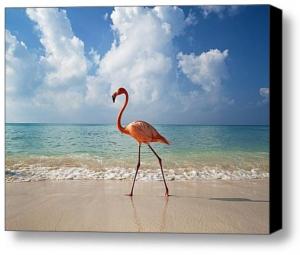Sale on canvas prints! Use code ABCXYZ at checkout for a special discount!

Pink is in and so are these facts about flamingos (courtesy of About.com)
1. There are only six species of flamingos, but they are found around the world from the Caribbean and South America to Africa, the Middle East and Europe.
2. The word "flamingo" comes from the Spanish and Latin word "flamenco" which means fire, and refers to the bright color of the birds' feathers.
3. While flamingos are considered wading birds, they are most closely related to grebes genetically.
4. Flamingos are strong but rare swimmers and powerful fliers, even though they're most often seen just wading.
5. When flying in a flock, the top speed of a flamingo can be as high as 35 miles per hour.
6. Flamingos hold their bills upside down while feeding, often for several hours a day, so they can filter out their food while skimming the water.
7. A flamingo chick's bill is small and straight, but will develop the distinct "break" curve after a few months.
8. Flamingos are monogamous birds that lay only a single egg each year. If that egg is lost or damaged, they do not typically lay a replacement.
9. Parent flamingos feed their chicks exclusively crop milk for 5-12 days after hatching. This high fat, high protein substance is not like mammalian milk, but is excellent nutrition for growing chicks.
10. Flamingo chicks are born gray or white and take up to three years to reach their mature pink, orange or red plumage.
11. The pink, orange or red color of a flamingo's feathers is caused by carotenoid pigments in their food, and a flamingo's diet includes shrimp, plankton, algae and crustaceans.
12. The greater flamingo is the largest flamingo species and can measure up to five feet tall, but only weighs a maximum of eight pounds. The lesser flamingo is the smallest and can reach three feet tall.
13. A adult flamingo's legs can be 30-50 inches long, which is longer than their entire body.
14. The backward bending "knee" of a flamingo's leg is actually the bird's ankle. The actual knee is very close to the body and is not visible through the bird's plumage.
15. Flamingos are gregarious birds that do not do well in very small flocks. While a typical flock is only several dozen birds, flocks of up to a million or more have been recorded.
16. A flock of flamingos is called a stand or a flamboyance.
17. Flamingos have a wild lifespan of 20-30 years, but in captivity have been recorded as living up to 50 years or longer.
18. The Andean flamingo is the most threatened of all flamingo species, and estimates show there to be only 30,000 of the birds left in the wild.
19. The most prominent threats to flamingos include predators, habitat loss and poaching for decorative feathers as well as humans hunting flamingos to gather eggs as food or to harvest their tongues as meat.
20. Don Featherstone of Massachusetts is the inventor of the pink plastic lawn flamingo, which has been gracing lawns since 1957.
See this month's "Limited Time Offer" for deep discounts on the Flamingo canvas print pictured above.